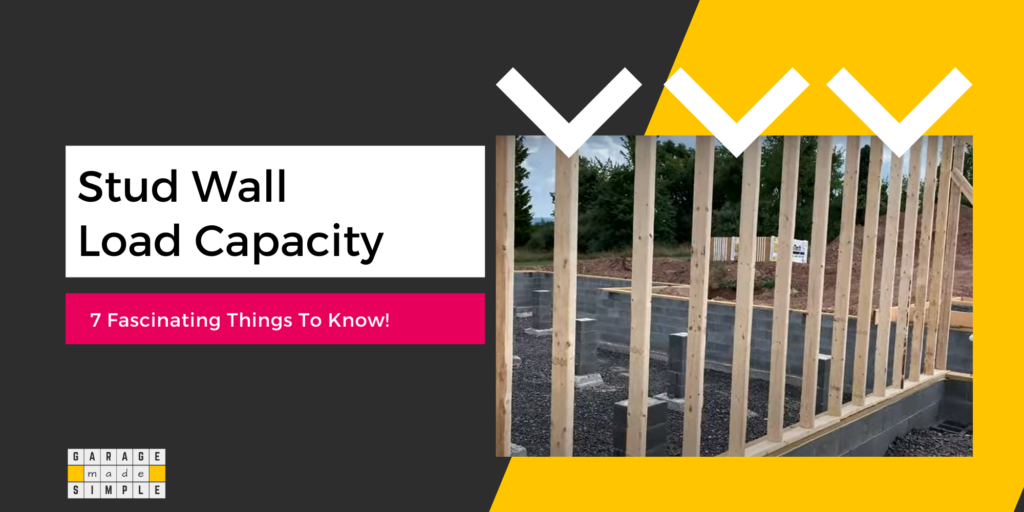Stud Wall Load Capacity: 7 Fascinating Things You Need To Know!
garagemadesimple.com is a participant in the Amazon Services LLC Associates Program, an affiliate advertising program designed to provide a means for sites to earn advertising fees by advertising and linking to Amazon.com . The website is also an affiliate of a few other brands.
1. What is Stud Wall Load Capacity?
Stud wall load capacity is the maximum weight a stud wall can support without collapsing. The load capacity of a stud wall depends on many factors. Some of these are:
- Type of Load: Load includes “Dead Load” (weight of the structure itself) and “Live Load” (weight of people and furniture).
- Stud Size: Larger studs have a higher load capacity than smaller studs. 2X6 studs are required for a house with 2 floors but 2X4 studs are sufficient for detached garages.
- Stud Spacing: The closer the spacing of the studs, the higher the load capacity of the wall.
- Stud Wood Type: Different types of wood have different strength properties. So the stud wall load capacity depends on the wood type of the studs. , which can affect how much weight a stud can support.
- Lumber Grade: Lumber that is graded as “No. 2” or “Select” will have a higher load capacity than lumber that is graded as “No. 3” or “Standard.”
- Sheathing Type & Thickness: The type of sheathing and its thickness can increase the load capacity of a stud wall.
- Layers of Sheathing: Adding more layers of sheathing will increase the load capacity of the wall.
- Fastener Spacing: Fasteners are used to attach vertical studs to sill plate, top plate, headers, etc. Fasteners are also used to attach the sheathing to studs: The closer the spacing of the fasteners, the stronger the joints and higher the load capacity.
- Insulation: Even wall insulation helps to increase the load capacity of a wall by adding stiffness and reducing the amount of deflection that occurs when the wall is loaded.

A typical load capacity for a stud wall made of standard lumber (2×4 or 2×6) is around 50-60 pounds per linear foot when spaced at 16 inches on center.
2. How Does Stud Size & Spacing Affect Load Capacity?
Stud Size:
Larger studs have a higher load capacity as compared to smaller studs because they have a larger cross-sectional area.
The 2X6 wood stud is in fact 1 ½” in width and 5 ½” in depth, while the 2X4 wood stud is 1 ½” in width and 3 ½” in depth. The cross sectional area of the 2X6 stud is 8 ¼ square inches while that of the 2X4 stud is 5 ¼ square inches.
The cross-sectional area of a 2X6 is 57% more than that of a 2X4. A 2X6 can therefore withstand more load before bending and breaking.
Stud Spacing:
Closer spacing of studs will increase the load capacity of a wall because there are more points of support to distribute the weight.
A 24’ long wall will have only 15 studs if they are 24” OC but have 21 studs if they are 16” OC. That’s 6 (40%) more studs. Naturally, the stud wall load capacity will be 40% higher.
NOTE: Number of studs are calculated using the Free Garage Wall Stud Calculator. Check it out!
3. What Are the Best Wood Types for High Stud Wall Load Capacity?
The stud wall load capacity depends on the species of the wood of which the stud is made as different species have different bending strengths. Other factors such as moisture content and lumber grade also have a role to play.
You can use the list below as a general guideline, if you like.
- Douglas Fir-Larch: Has high strength-to-weight ratio and is possibly one of the strongest North American softwoods.
- Hem-Fir: Has good strength and stiffness properties and is widely used for structural framing.
- Southern Yellow Pine (SYP): Has good bending strength and is often used as joists.
- Spruce-Pine-Fir (SPF): Has reasonable bending strength properties. Use it for a detached garage without batting an eyelid, but go for Douglas Fir-Larch or Hem-Fir for your home.
- White Pine: Don’t even bother. It has relatively low strength and is not recommended for structural framing.
4. Does Type of Sheathing Affect Stud Wall Load Capacity?
The type of sheathing used on a stud wall can affect the stud wall load capacity. Sheathing adds stiffness and strength to a wall.
Plywood and OSB (Oriented Strand Board) are strong and stiff sheathing materials. Plywood is made up of several layers of wood veneer that are glued together. OSB is made up of thin wood strands glued together and formed into a panel under heat and pressure.
Both, Plywood & OSB can increase the load capacity of a stud wall significantly.
Thickness & Fastener Spacing
Thickness of sheathing and spacing between fasteners used to attach it to the studs, also affects the wall’s load capacity. The thicker the sheathing, the more support it provides to the wall. The closer the spacing between the fasteners, the stronger the connection between the sheathing and the studs.
Number of Layers
Generally speaking, adding more layers of sheathing will increase the load capacity of the wall. For example, two layers of ⅜ “ thick plywood will provide a higher load capacity than a single layer of ¾ “ thick plywood.
5. Does Insulation Increase Stud Wall Load Capacity?
Insulation is added to walls to improve the thermal performance, but it also helps to increase the wall’s load capacity.
Insulation adds stiffness to the wall and reduces the amount of wall deflection under load. The additional stiffness helps to distribute the load more evenly throughout the wall, reducing the risk of failure in any one area.
However, for insulation to be effective it must be installed correctly. Insulation that is not properly secured or compressed will not only reduce the insulation effectiveness but also reduce the load capacity of the wall.
Owens Corning R 15 Kraft Faced Fiberglass Batt Fits 2X4 Stud Walls
Owens Corning 678 SQFT 10 Bags of R 15 Kraft Faced 15 by 93 Fiberglass Batt Fits 2X4 Walls
Owens Corning EcoTouch PINK Fiberglass Insulation with PureFiber Technology is a preformed, flexible blanket insulation. It is produced in R-values from 11 to 49, with thicknesses ranging from 31/2 inches to 14 inches. It is available unfaced, or faced with either a kraft or foil vapor retarder.
6. What are Applicable Building Codes?
Section R602 Wood Wall Framing of the 2021 International Residential Code (IRC) lays down the applicable provisions to which load bearing wood and wood products must conform.
Chapter 23 of the 2021 International Building Code (IBC) provides the minimum requirements for the design of buildings and structures that use wood and wood based products.
The chapter is organized around 3 design methodologies: Allowable Stress Design (ASD), Load and Resistance Factor Design (LRFD) and Conventional Light Frame Construction.
7. How to Calculate Stud Wall Load Capacity?
Calculation of stud wall load capacity is best done by knowledgeable and experienced professionals as several factors are involved. They also need to comply with building codes and best practices.
As discussed above the factors that professionals incorporate in their calculations include (but are not limited to):
- Type of Load
- Stud Size
- Stud Spacing
- Stud Wood Type
- Lumber Grade
- Sheathing Type & Thickness
- Layers of Sheathing
- Fastener Spacing
- Insulation
Thank you very much for reading the post. I do hope you found it informative and useful.







